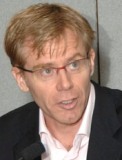
 |
| News & Outreach |
|
||||||
Global Health MattersSeptember - October, 2007 | Volume 6, Issue 5
Fogarty Co-sponsors Polio Symposium Examining Eradication Efforts

While international efforts to eradicate polio have made significant progress, complete elimination of the virus is proving to be more difficult than expected. Scientists, funders, government officials and policy makers gathered to discuss the challenges recently at an NIH symposium sponsored by Fogarty and the National Institute of Allergy and Infectious Diseases. The two-day meeting, Polio Immunization: Moving Forward, included presentations on the current status of eradication, the challenges impeding progress, available vaccine options and the research agenda needed to advance the effort. Welcoming remarks were made by Fogarty Director, Dr. Roger I. Glass, who gave a personal perspective of the epidemic that created such fear during his childhood. Since 1988, the World Health Organization’s eradication efforts have eliminated wild poliovirus from more than 100 countries, with only four currently identified as endemic and 13 as reinfected, or having more than two cases in the same transmission, according to Dr Bruce Aylward, WHO’s Director for Polio Eradication. He reports that the number of paralyzed children has dropped by 99 percent since the $5.3 billion effort began.  WHO's Dr. Bruce Aylward discussed polio eradication efforts. However, Aylward identified significant impediments to eradication, including the biological nature of the virus, the reversion properties of the oral vaccine, difficulties conducting surveillance, epidemiological features of the disease under different field situations, among others. A two-pronged approach is needed to both strengthen strategies and improve their application, he suggested, while acknowledging the situation will need long-term attention. “After interruption of wild poliovirus transmission globally, the concerted program of work to stop all polio disease will need to continue,” he said. Dr. Jacob John of the Christian Medical College in India, chaired a panel of representatives from India, Nigeria, Pakistan and Ghana—who discussed a range of scientific evidence related to challenges of polio eradication in their countries. Security issues prove a challenge in Pakistan and Afghanistan, while cultural issues were cited by Nigeria. Other presentations reviewed the latest data regarding live trivalent and monovalent polio vaccines as compared to the inactivated polio vaccine. Further discussions included possible alternatives in the research pipeline, as well as consideration of the most effective approach once eradication has been achieved. Many participants advocated for increasing resources devoted to eradication to achieve success. “This effort has not been a failure, although it has failed to deliver its ultimate goal,” stated Dr. Walter Orenstein of Emory University. “We need to throw all weapons at it.” Should you require Adobe Acrobat for viewing PDFs, current and free accessible plug-ins are available at the Adobe website.
|
|||||||
|